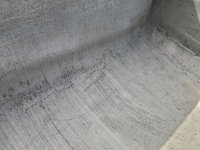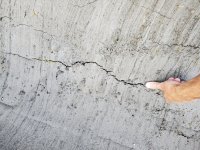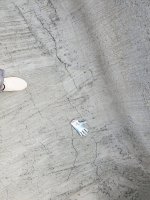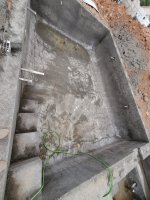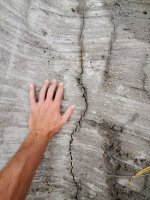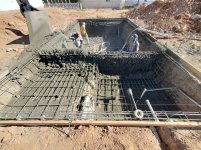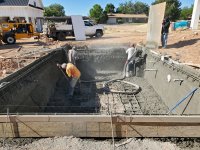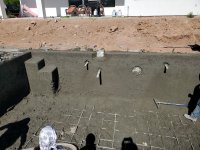Greetings again TFP!
My post today is filled with excitement and concern. I've done service and repair for pools for many, many years, and as of last week - the pool guy is finally getting a pool!
I will concede, we are very good at servicing and repairing the systems of our several hundred service clients, but I am NOT a builder. I have minimal experience here to fall back on with regard to the specialized areas within pool building. We do startups every week, but we've never built one.
I am using a reputable builder, one that's been in the business for decades. I've also cared for his clients pools for years with zero problems. It's why we chose him for our personal pool. We've been grateful to have someone we trust do our pool.
Fast forward to yesterday (Friday, 6/17/22), and we had the shell shot. I'm going to call it Shotcrete, because my understanding tells me that's what it is; the mix arrived in a compartmented truck (ready-mix/site-mix), and the concrete truck dumped the wet mix directly into a pump trailer, that only mixed with air.
Back to reputational background - the crew doing the Shotcrete has also been around for decades. They are actually one of only two Shotcrete options in our area, with the other option being his old partner. In short, this Shotcrete company has done nearly every pool in SoUtah and have a good rep. I chatted with the foreman before they shot it, and it was clear he was knowledgable and proud of their PSI numbers and track record. I was feeling very confident and grateful this entire build and even through that point.
That was, until the Shotcrete had sat for a few hours. And gnarly cracks began to occur before I even had a chance to wet it.
They started early, but we hit 100 degrees by noon. To make it worse, we had 25mph southern winds beating on us. This said, that's the norm for SoUtah (we are generally mirror Vegas weather within a few degrees) so this was not their first time in these circumstances. I sent pictures of the cracks to my builder, and he was not concerned in the least. So naturally, I went online to make sure I understood why I was over-worried. Except, the result was that I grew more concerned.
> One shoulder-angel tells me they are plastic-shrinkage cracks because of the brutal heat and wind curing the outside at a much faster rate. If so, I have a sense of relief that these aren't structural and shouldn't telegraph through the plaster.
> The other shoulder-angel tells me, it's because they said they had to use a mix with fly-ash due to powder shortages (which is not their preference, they prefer pure powder) and because they used the rebound. I did not see them pack stairs or walls with it, but it was definitely carved off and shoveled below the floor rebar, and then they shot on top of it. I'm worried this may mean the cracks are more than cosmetic, and it'll leak.
The images show pretty well, that 99% of the cracks are in the floor and the transition to the wall. The walls themselves are virtually crack-free.
I've attached 3 images below are of the Shotcrete a few hours after the crew left (the dry-looking images) and then 2 of what it looks like after 24 hours of intermittent wetting (the obviously wet ones).
Please let me know if I'm falling for ignorant fear on this. I just can't make heads or tails of the advice online for other folks who have posted pictures looking for advice. I'm trying to verify if I have to act more alarmed than my builder seems to be.
My post today is filled with excitement and concern. I've done service and repair for pools for many, many years, and as of last week - the pool guy is finally getting a pool!
I will concede, we are very good at servicing and repairing the systems of our several hundred service clients, but I am NOT a builder. I have minimal experience here to fall back on with regard to the specialized areas within pool building. We do startups every week, but we've never built one.
I am using a reputable builder, one that's been in the business for decades. I've also cared for his clients pools for years with zero problems. It's why we chose him for our personal pool. We've been grateful to have someone we trust do our pool.
Fast forward to yesterday (Friday, 6/17/22), and we had the shell shot. I'm going to call it Shotcrete, because my understanding tells me that's what it is; the mix arrived in a compartmented truck (ready-mix/site-mix), and the concrete truck dumped the wet mix directly into a pump trailer, that only mixed with air.
Back to reputational background - the crew doing the Shotcrete has also been around for decades. They are actually one of only two Shotcrete options in our area, with the other option being his old partner. In short, this Shotcrete company has done nearly every pool in SoUtah and have a good rep. I chatted with the foreman before they shot it, and it was clear he was knowledgable and proud of their PSI numbers and track record. I was feeling very confident and grateful this entire build and even through that point.
That was, until the Shotcrete had sat for a few hours. And gnarly cracks began to occur before I even had a chance to wet it.
They started early, but we hit 100 degrees by noon. To make it worse, we had 25mph southern winds beating on us. This said, that's the norm for SoUtah (we are generally mirror Vegas weather within a few degrees) so this was not their first time in these circumstances. I sent pictures of the cracks to my builder, and he was not concerned in the least. So naturally, I went online to make sure I understood why I was over-worried. Except, the result was that I grew more concerned.
> One shoulder-angel tells me they are plastic-shrinkage cracks because of the brutal heat and wind curing the outside at a much faster rate. If so, I have a sense of relief that these aren't structural and shouldn't telegraph through the plaster.
> The other shoulder-angel tells me, it's because they said they had to use a mix with fly-ash due to powder shortages (which is not their preference, they prefer pure powder) and because they used the rebound. I did not see them pack stairs or walls with it, but it was definitely carved off and shoveled below the floor rebar, and then they shot on top of it. I'm worried this may mean the cracks are more than cosmetic, and it'll leak.
The images show pretty well, that 99% of the cracks are in the floor and the transition to the wall. The walls themselves are virtually crack-free.
I've attached 3 images below are of the Shotcrete a few hours after the crew left (the dry-looking images) and then 2 of what it looks like after 24 hours of intermittent wetting (the obviously wet ones).
Please let me know if I'm falling for ignorant fear on this. I just can't make heads or tails of the advice online for other folks who have posted pictures looking for advice. I'm trying to verify if I have to act more alarmed than my builder seems to be.
Attachments
Last edited:


